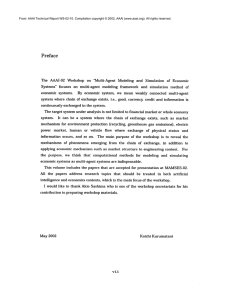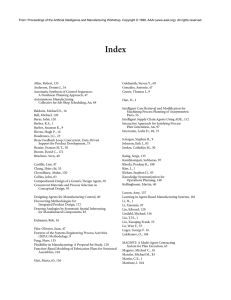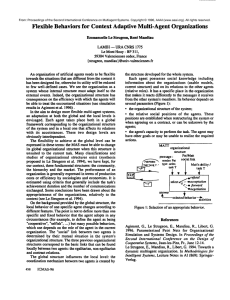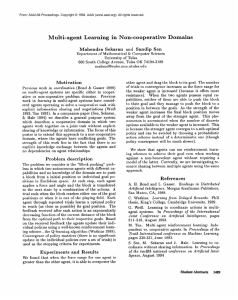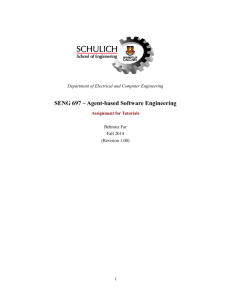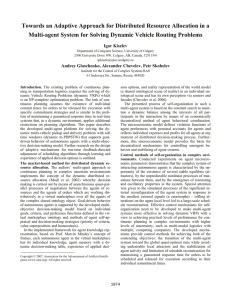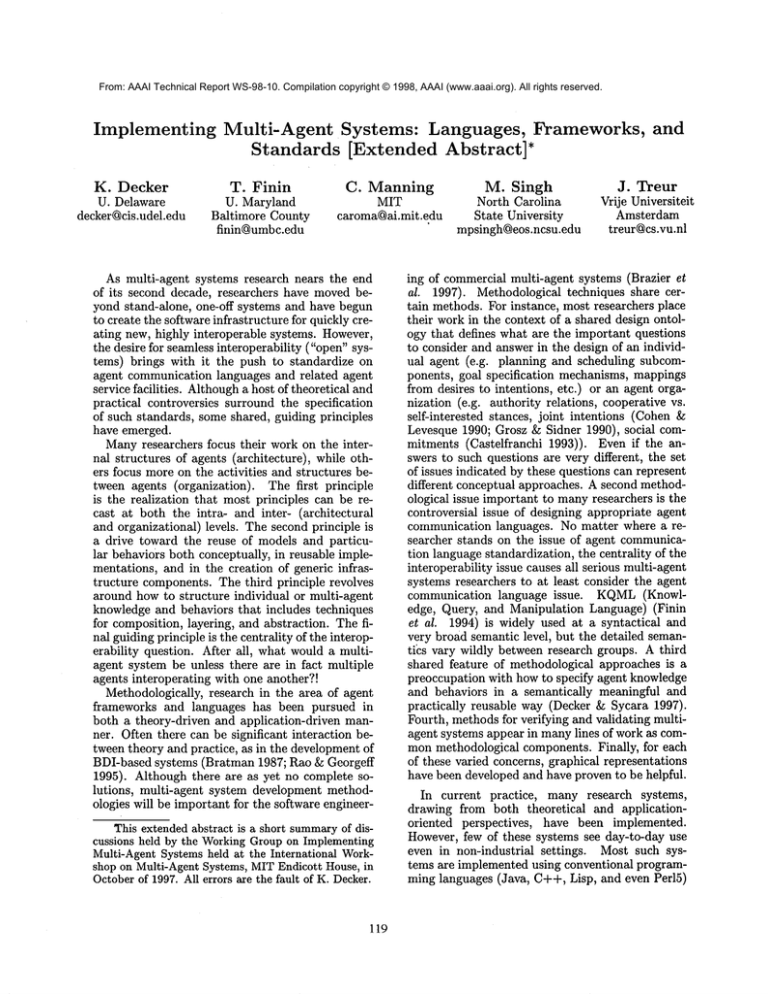
From: AAAI Technical Report WS-98-10. Compilation copyright © 1998, AAAI (www.aaai.org). All rights reserved.
Implementing
K. Decker
U. Delaware
decker@cis.udel.edu
Multi-Agent Systems: Languages, Frameworks,
Standards [Extended Abstract]*
T. Finin
U. Maryland
Baltimore County
fininQumbc.edu
C.
Manning
MIT
caroma@ai.mit.edu
As multi-agent systems research nears the end
of its second decade, researchers have moved beyond stand-alone, one-off systems and have begun
to create the software infrastructure for quickly creating new, highly interoperable systems. However,
the desire for seamless interoperability ("open" systems) brings with it the push to standardize on
agent communication languages and related agent
service facilities. Althougha host of theoretical and
practical controversies surround the specification
of such standards, some shared, guiding principles
have emerged.
Manyresearchers focus their work on the internal structures of agents (architecture), while others focus more on the activities and structures between agents (organization). The first principle
is the realization that most principles can be recast at both the intra- and inter- (architectural
and organizational) levels. The second principle is
a drive toward the reuse of models and particular behaviors both conceptually, in reusable implementations, and in the creation of generic infrastructure components. The third principle revolves
around how to structure individual or multi-agent
knowledge and behaviors that includes techniques
for composition, layering, and abstraction. The final guiding principle is the centrality of the interoperability question. After all, what would a multiagent system be unless there are in fact multiple
agents interoperating with one another?!
Methodologically, research in the area of agent
frameworks and languages has been pursued in
both a theory-driven and application-driven manner. Often there can be significant interaction between theory and practice, as in the development of
BDI-based systems (Bratman 1987; Rao & Georgeff
1995). Although there are as yet no complete solutions, multi-agent system development methodologies will be important for the software engineerThis extended abstract is a short summaryof discussions held by the WorkingGroup on Implementing
Multi-Agent Systems held at the International Workshop on Multi-Agent Systems, MITEndicott House, in
Octoberof 1997. All errors are the fault of K. Decker.
119
M. Singh
North Carolina
State University
mpsingh@eos.ncsu.edu
and
J. Treur
Vrije Universiteit
Amsterdam
treur@cs.vu.nl
ing of commercial multi-agent systems (Brazier et
al. 1997). Methodological techniques share certain methods. For instance, most researchers place
their work in the context of a shared design ontology that defines what are the important questions
to consider and answer in the design of an individual agent (e.g. planning and scheduling subcomponents, goal specification mechanisms, mappings
from desires to intentions, etc.) or an agent organization (e.g. authority relations, cooperative vs.
self-interested stances, joint intentions (Cohen
Levesque 1990; Grosz & Sidner 1990), social commitments (Castelfranchi 1993)). Even if the
swers to such questions are very different, the set
of issues indicated by these questions can represent
different conceptual approaches. A second methodological issue important to manyresearchers is the
controversial issue of designing appropriate agent
communication languages. No matter where a researcher stands on the issue of agent communication language standardization, the centrality of the
interoperability issue causes all serious multi-agent
systems researchers to at least consider the agent
communication language issue. KQML(Knowledge, Query, and Manipulation Language) (Finin
et al. 1994) is widely used at a syntactical and
very broad semantic level, but the detailed semantits vary wildly between research groups. A third
shared feature of methodological approaches is a
preoccupation with how to specify agent knowledge
and behaviors in a semantically meaningful and
practically reusable way (Decker & Sycara 1997).
Fourth, methods for verifying and validating multiagent systems appear in manylines of work as commonmethodological components. Finally, for each
of these varied concerns, graphical representations
have been developed and have proven to be helpful.
In current practice, many research systems,
drawing from both theoretical and applicationoriented perspectives,
have been implemented.
However, few of these systems see day-to-day use
even in non-industrial settings. Most such systems are implemented using conventional programming languages (Java, C++, Lisp, and even Perl5)
rather than in languages developed exclusively for
multi-agent systems programming. Partial reuse of
agent subcomponents, and even whole agents (especially general service-oriented agents such as agent
name servers, matchmakers, facilitators,
and brokers) has been demonstrated many times (though
mostly within particular research groups). Agent
communication languages are common,but usage is
fairly idiosyncratic within groups (e.g. manyvariations on KQML).Clearly building good systems
for simple applications is feasible and is no longer
an interesting research question. Similarly clearly,
there are frameworks and tools that are being used
over extended periods of time for multiple projects.
However,not all available theoretical results have
been exploited by application or general framework
designers, and there exist some applications that
are in need of supporting theory.
Several research issues in the general area of
agent languages and frameworks are being actively
pursued. The first is the question of just howsimilar agent communication languages need to be to
humanlanguages. Most of the current popular approaches are based on speech act theory (Searle
1969), but of course there is no necessity for artificial languages to be limited by human prototypes.
A second important issue is how agents should some
to decide how much trust to place in others, and
whomto believe. This general issue encompasses
varied ideas ranging from deciding between cooperativity or self-interest to tracking the reliability
of certain information and highly practical research
into agent authentication methods. Another issue
is how best to facilitate industrial acceptance of
agents, which is made more complex by the use
of the term "agent" by some commercial software
developers in contexts only very tenuously related
to any sense of the term as used in the multi-agent
systems field. As infrastructure matures, an issue
arises in howthe developing multi-agent infrastructure is integrated with existing networking technology. An example of this is how the use of UDPor
other network transport mechanisms (as opposed to
TCP) would impact popular agent communication
languages such as KQML.A fifth issue is that of
agent communication language evolution--even if
agents could interoperate initially with some standard, how could the agents themselves automatically extend communication and content languages
appropriately.
Besides the agent communication
language issue, interoperability of internal agent architectural componentsis an active issue. With the
necessity in manyapplications of agents that plan,
schedule, reason about beliefs, form coalitions, negotiate, etc. comes the desire to share and reuse
such reasoning components. Finally, multi-agent
systems language designers face the need to overcome the impression of industrial programmers that
Java is sufficient for all agent development needs.
120
For the language and framework researcher, it is
not so muchthe rise of a "killer multi-agent app"
that is desired as the rise of a true hit toolkit to
spread use and attract interest.
Work on standards proceeds along several different fronts. One level of standards is for standard agent roles and capabilities.
For example,
how do agents find one another? Such high level
infrastructure can be built now, relying on wellunderstood public services, such as agent name
servers, matchmaker/yellow-page services, service
brokering, mediators, facilitators, translation services, and so on. Another level of standards is
at the transmission protocol level, one easier to
agree on than that of core agent communication
languages. Most proposed agent communication
languages have at least some notion of a separate, extensible (or retargetable) "content" language where domain-specific information is communicated. These can be standardized on, even
informally, within commondomains (for example,
the agent services ontology implied above of broker, matchmakers, mediators, etc.). Finally, there
have been some proposals for tagging data on the
web with appropriate meta-data tags so that websearching agents would have an easier time of drawing out the appropriate information from web pages
formatted more for humanreadability than for consumption by autonomous software agents.
Finally, many controversies still range in the
agent language and framework area. The semantics
of agent communicationlanguages is a very controversial area. Arguments range from those who want
languages simple enough to be easily implemented
and validated, to those whodesire the capabilities
of much more complex agent communication languages that can be extended on the fly. Another
question is howseparate the semantics of an agent
communication language can be from the internal
architecture of the agents. Another controversy revolves around the usefulness of testbeds for agent
implementation research. Nowthat non-simulated
networks are so commonplaceand easy to achieve,
there is a question of how muchtrust to put into
limited testbeds. Even a well-defined testbed problem can sometimes introduce regularities (or irregularities) that are not present in the real problem
domain, and steps must be taken that this does not
effect the resulting research results. On the other
hand, testbeds allow a remarkable amount of comparability in results between different groups and
approaches, and also sometimes the ability to do
careful, well-instrumented, paired-response studies.
Another controversy in the implementation area
is the impact of so-called "mobile" agents--in their
purest form, software agents that can suspend execution on one platform, transfer their code, and
resume execution on a remote platform. While the
technology to do this already exists, the question
remains as to what it is useful /or. Tremendous
numbers of test systems have been built both in
research and commercially, but few compelling applications
have appeared. The two most common
involve hand-held computing devices (PDAs) that
are only intermittently connected to the network.
A mobile agent can clearly transfer off such a device to do work, ad transfer back later. The second involves running complex data-dependent code
(say, involving a large database) without having
transfer the data over the network--instead, the
agent goes to the data. The non-compelling nature
of these examples appears when we consider how
these things actually get done: typically, the agent
must be running "on" some software platform that
is providing some security and otherwise protecting the underlying machine from rogue agents; the
agent then must transfer to another such platform.
These platforms can be considered as nothing more
than NON-mobile agents, and the "mobile" agents
are nothing more than fairly complex messages that
contain not only a description of a task to do, but
also specific code to carry out that task.
Another perennial controversy involves the structure of the agent’s internal architecture:
how
many layers? Should it be application dependent?
Other arguments ensue over cooperatively designed
multi-agent systems, totally self-interested individual agents, and useful ways at arriving at socially
constructed mutual beliefs. Yet another architectural question aims at scalable models: can an "organization" (made up of many agents) be thought
of itself as a kind of "agent" ? Clearly organizations
(take human organizations
as an example) have
some agent-like properties, for example the ability
to make commitments. An organizational
commitment to deliver a particular product is clearly not a
commitmentof any single individual in the organization. On the other hand, it appears that some of
the simple models that we typically use to understand the actions of individual agents (such as BDI
models) may break down somewhat when trying
to cope with the observed actions of large organizations operating mostly via standardized operating procedures and responses. An "organizational
goal" or desire is clearly not a simple function of
the goals of the organizations individuals, nor are
the goals of the individuals a simple function of the
organizational goals.
Finally, agent language work brings a set of
controversies related to the purposes of such languages. Some are true "programming" languages,
while others might be more properly characterized
as "modeling" languages. Should work in the field
be more organized towards providing toolkits built
in existing languages (e.g. Java), or in extending
existing traditional programming languages, or in
fact creating totally new languages? An orthogonal controversy revolves around the need for dif-
121
ferent languages at different levels: building individual behaviors of an agent, building the agent’s
internal architecture, building inter-agent communication languages and coherent coordination protocols, and building multi-agent organizations.
The current prospects and outlook for this segment of the field is good. Clearly much larger
and more complex systems are being constructed
as time goes on. These bigger and better systems
are being applied to new and different application
areas, moving from Internet information retrieval
to more complex information gathering and integration applications. Areas such as manufacturing
are drawingfresh attention in the multi-agent field.
Newsoftware tools, especially graphical specification interfaces, are being built and will be very important for spreading the use of multi-agent techniques and enlisting new allies, especially amongindustrial users. Newmethodologies for multi-agent
system software engineering promise quicker and
more consistent design results. Finally, while standards are still emerging, the concentration on a few
competing possibilities has and will continue to enhance reusability and interoperability.
References
Bratman, M. 1987. Intention, Plans, and Practical Reason. Cambridge, MA:Harvard U. Press.
Brazier, F.; Keplicz, B.; Jennings, N.; and Treur,
J. 1997. Formal specification of multi-agent systems: a reM-world case. In Proceedings of the 1st
Intl. Conf. on Autonomous Agents, 25-32.
Castelfranchi, C. 1993. Commitments:fromindividual intentions to groups and organizations. In
Prietula, M., ed., AI and theories of groups ~A organizations: Conceptual and Empirical Research.
AAAIWorkshop. Working Notes.
Cohen, P. R., and Levesque, H. J. 1990. Intention
is choice with commitment.Artificial Intelligence
42(3):213-261.
Decker, K. S., and Sycara, K. 1997. Intelligent
adaptive information agents. Journal of Intelligent
Information Systems 9(3):239-260.
Finin, T.; Fritzson, R.; McKay,D.; and McEntire,
R. 1994. KQML
as an agent communication language. In Proceedings of the Third International
Conference on Information and Knowledge Management CIKM’94. ACMPress.
Grosz, B., and Sidner, C. 1990. Plans for discourse. In Cohen, P.; Morgan,J.; and Pollack, M.,
eds., Intentions in Communication. MITPress.
Rao, A., and Georgeff, M. 1995. BDI agents: From
theory to practice. In Proceedings of the First International Conference on Multi-Agent Systems,
312-319. San Francisco: AAAIPress.
Searle, J. R. 1969. Speech Acts: An Essay in the
Philosophy of Language. Cambridge U. Press.

